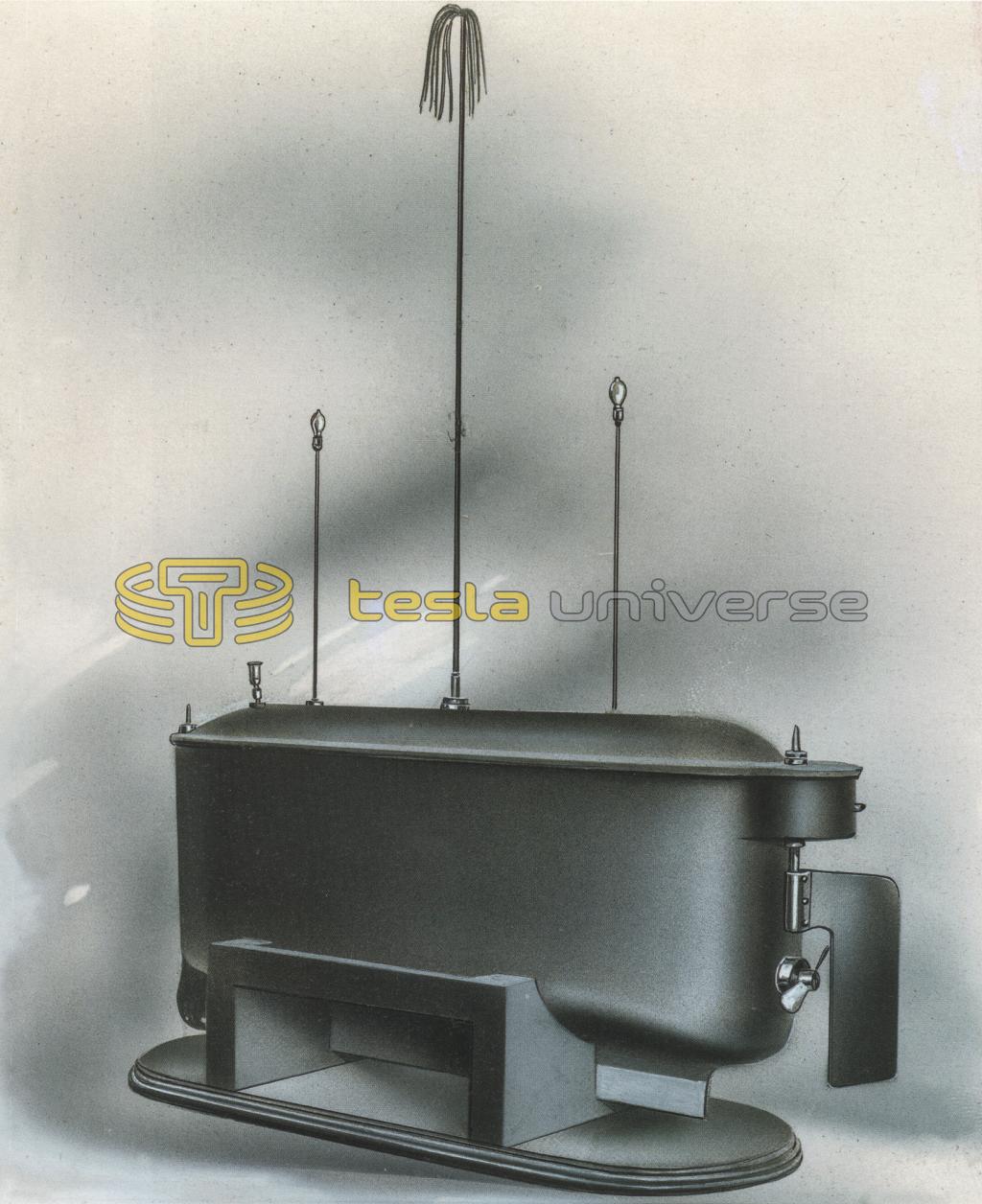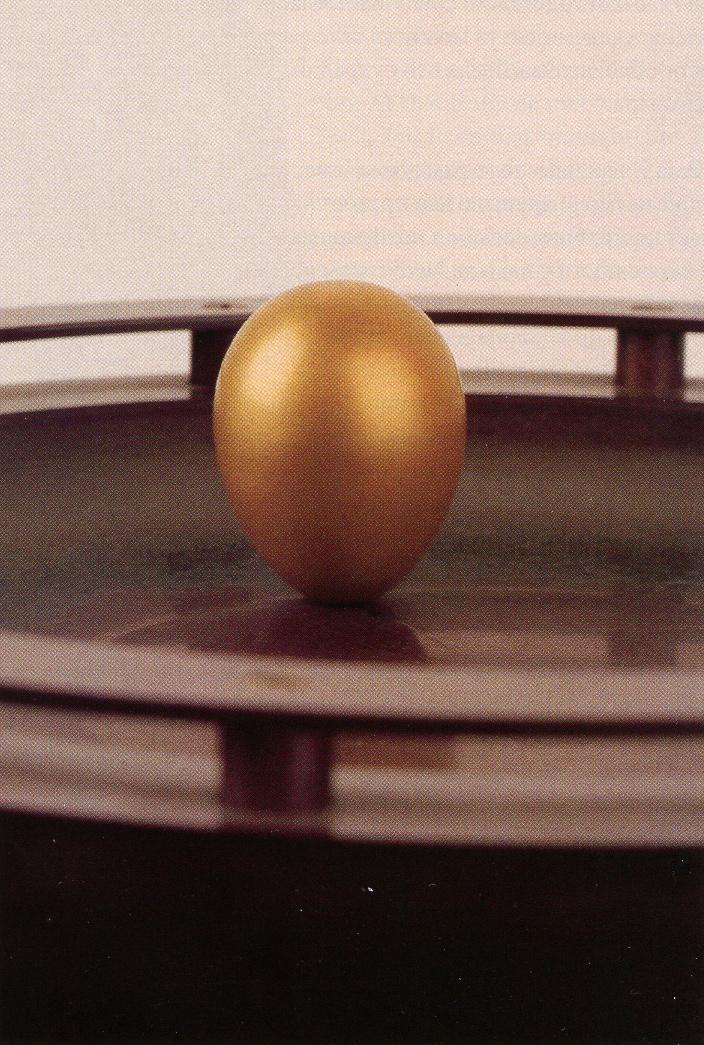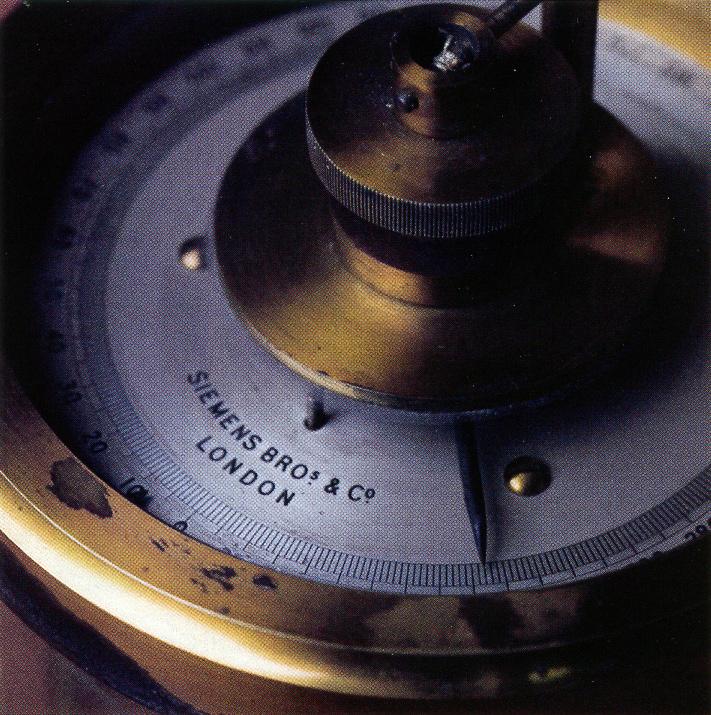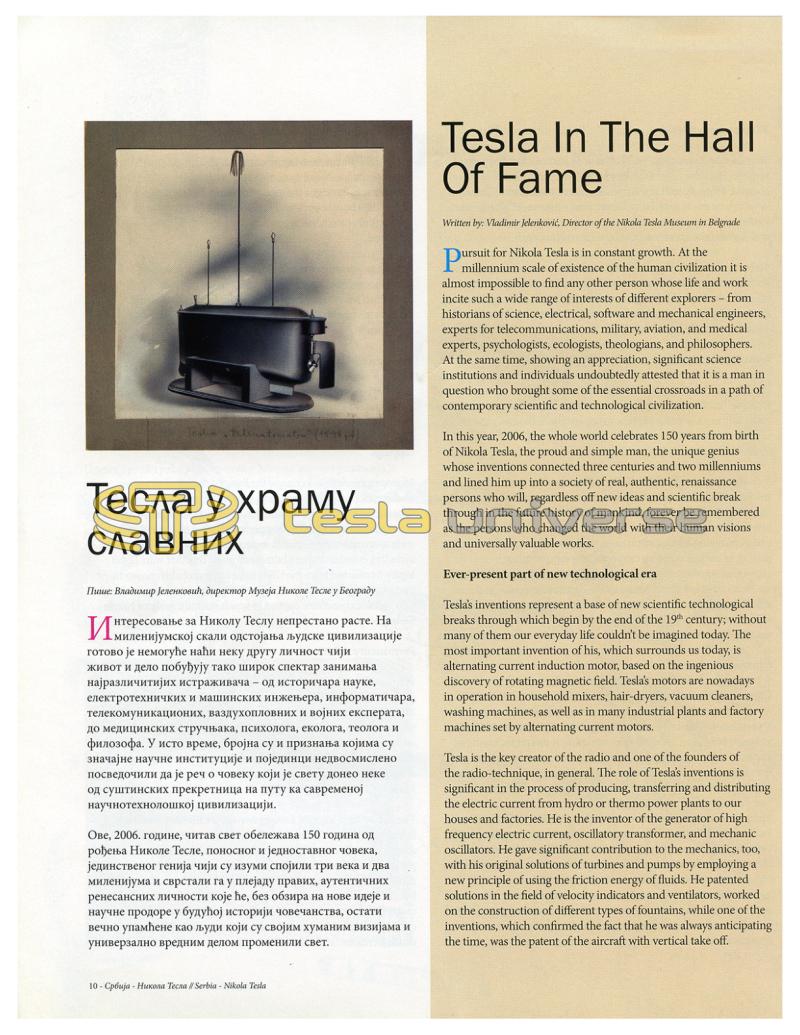
Nikola Tesla Articles
Tesla in the Hall of Fame
Pursuit for Nikola Tesla is in constant growth. At the millennium scale of existence of the human civilization it is almost impossible to find any other person whose life and work incite such a wide range of interests of different explorers - from historians of science, electrical, software and mechanical engineers, experts for telecommunications, military, aviation, and medical experts, psychologists, ecologists, theologians, and philosophers. At the same time, showing an appreciation, significant science institutions and individuals undoubtedly attested that it is a man in question who brought some of the essential crossroads in a path of contemporary scientific and technological civilization.
In this year, 2006, the whole world celebrates 150 years from birth of Nikola Tesla, the proud and simple man, the unique genius whose inventions connected three centuries and two millenniums and lined him up into a society of real, authentic, renaissance persons who will, regardless of new ideas and scientific breakthrough in the future history of mankind, forever be remembered as the persons who changed the world with their human visions and universally valuable works.
Ever-present Part of New Technological Era
Tesla’s inventions represent a base of new scientific technological breakthroughs which begin by the end of the 19th century; without many of them our everyday life couldn’t be imagined today. The most important invention of his, which surrounds us today, is the alternating current induction motor, based on the ingenious discovery of rotating magnetic field. Tesla’s motors are nowadays in operation in household mixers, hair-dryers, vacuum cleaners, washing machines, as well as in many industrial plants and factory machines set by alternating current motors.
Tesla is the key creator of the radio and one of the founders of the radio-technique, in general. The role of Tesla’s inventions is significant in the process of producing, transferring and distributing the electric current from hydro or thermo power plants to our houses and factories. He is the inventor of the generator of high frequency electric current, oscillatory transformer, and mechanic oscillators. He gave significant contribution to the mechanics, too, with his original solutions of turbines and pumps by employing a new principle of using the friction energy of fluids. He patented solutions in the field of velocity indicators and ventilators, worked on the construction of different types of fountains, while one of the inventions, which confirmed the fact that he was always anticipating the time, was the patent of the aircraft with vertical take off.
Prestige Medals
In some periods in Tesla’s life, numerous respectable scientific institutions and associations of experts competed to be the first to decorate him with an order wishing to pay a tribute for his scientific achievements which made the world more prosperous. In the collection of the Nikola Tesla Museum in Belgrade, there are 56 of those prizes, including the certificates which accompanied the orders and medals, honour doctorate charters, as well as certificates of academies of science, expert associations and different societies.
During his life, Tesla was decorated six times. He received prestige medals from the field of electrical engineering, Gold Medal of Eliot Creson of Franklin Institute, Gold Medal of Thomas Edison of American Institute of Electrical Engineers and Gold Medal of John Scott of the City of Philadelphia. He received the Honour Doctorate Charters for thirteen times. Among institutions which honoured him this way are Columbia College, Yale University, Faculty of Engineering - the University of Belgrade, High Technical School in Vienna, Graz-Leoben University of Technology and Mining in Graz, Zagreb University, Czech University of Technology in Prague, the University of Technology of Dr. Edvard Benes in Brno, the University of Paris, Grenoble University, Poitiers University, Polytechnic School of Carol II in Bucharest and the University of St Kliment of Ohrid in Sofia.
Membership in the Serbian Royal Academy
The Serbian Royal Academy, one of the institutions especially significant both to us and to Tesla, understood at the very beginning all the grandeur of his work and on February 22nd 1894 announced him for its associate member. That happened partially due to his only visit to Belgrade, made almost two years earlier, in June 2nd 1892. He was welcomed with the highest honour, he met King Alexander I Obrenovic, Serbian Ministers, representatives of the Belgrade Municipality, professors of The Grande School and The Educational Institute, representatives of different companies and associations and evoked great respect and admiration as a young and famous Serbian-originating scientist who rose reputation of his homeland and of all the Serbian people.
Unfortunately, this respectable institution needed 43 years to accept him at least as a regular, i.e. “real member”, as that rank was denoted then.
On February 17, 1937, Serbian Royal Academy sends him the telegram with the report from the previous day that he is, at the main annual meeting, elected unanimously for the real member of the Academy and asks him to confirm the reception of this information by the telegraph. The next day, on February 18th, Tesla humbly responds:
“Your yesterday’s telegram brought me the news that you accepted me into your undying society as the real member. It is the unique and great honour that I deeply feel and completely appreciate and accept it with pride and gratitude hoping that, with the course of time, it will be considered deserved.
Nikola Tesla”
Finally, on 7th March 1937, Aleksandar Belic, the President of the Serbian Royal Academy sends a letter to Nikola Tesla that finally ended the stage of a too long anticipation for the most respectable scientific institution to accept under its roof one of the greatest minds and creators:
“Dear Sir,
I am honoured to inform you that the Serbian Royal Academy received your radio-message with which you accepted to be elected for its real member. At today’s annual assembly I had the honour to pronounce you for the real member of the Serbian Royal Academy and introduce you into all the rights which real members have.
Kindly find enclosed to this letter the membership certificate and the symbol which the real members of the Serbian Royal Academy are entitled to carry according to the Statute.
The Academy would be glad to print your biography in its Annual. If you may please to write and send your biography to the Academy, the Academy would be very thankful to you.
With great respect,
The president of the Serbian Royal Academy,
A. Belic”
The Book of Greetings for Tesla’s 75th Birthday
One book, richly bound in leather binding with gold finishing which Tesla jealously kept in his treasure chest till the end of his life was a real treasure of acknowledgments to the great scientist and inventor. That book represents, in fact, original, unique collection of letters sent by his contemporaries to him for his 75th birthday.
It was the idea of Kenneth M. Swezey, (1905 - 1972), American journalist and writer, a close friend of Tesla’s and a great admirer of his, to ask 75 chosen persons to send him greetings which will be incorporated into this unusual collection. In his early days, Swezey writes for the New York Sun. At that time, he met Nikola Tesla, and from that moment, he dedicates a great deal of his life to studying and promoting of Tesla’s inventions and its significance. As an editor and author of many works from the field of science, he often wrote about Tesla and his scientific contribution, he founded the Tesla Society, organized the celebration of 100 years of Tesla’s birth and masterminded different activities on promoting the name of Tesla. Thanks to him, many ships and schools in the USA got Tesla’s name. He was one of many voices who initiated the naming of the magnet induction unit in the International System of Measures by his name and issuing the post stamp in remembrance of the ingenious scientist and inventor.
After Swezey’s death, the Smithsonian Institute took over his rich archive collected from 1921 till 1972 which consists of correspondence between Tesla and Swezey, as well as between Tesla and other persons, Tesla’s texts, patents, press clippings and photographs, as well as the material regarding the history of electricity and radio industry. From the Department of Electricity where it used to be kept Swezey’s inheritance was transferred into Archive Centre of the National Museum of the American History in Washington in 1983, where it is nowadays.
From the correspondence which Swezey had with a great number of scientists, engineers and the representatives of big corporations about the letters which they wanted to address to Tesla for his 75th birthday, it is notable that the correspondence had begun as early as at the beginning of 1931, with the idea to complete the whole action till July 10, 1931 - the date of Tesla’s great jubilee.
This collection of the original greetings, written by hand or typewriter, has been entitled: “To Nikola Tesla greeting his Seventy-fifth Anniversary, July 10, 1931”
The list of famous names is long, altogether 75 authors of those greetings, who, as Tesla did, marked the age with their remarkable deeds: Albert Einstein, B. A. Behrend, William Henry Bragg, Lee de Forest, Arthur H. Morse, professor John B. Whitehead and many other famous American and European persons, as well as important Serbian scientists and creators as Milutin Milankovic, engineer Slavko Bokshan, professor Nikola T. Petrovic, Uros Predic, professor Dragomir Jovanovic and professor Ivan Djaja.
In the Scientific Temple of Outstanding Persons
The greatest acknowledgement which one can achieve in the world of science is naming of some of the units in the International Measure System (SI) after the name of an extraordinary person who changed the development course of our civilization. By the Decision of the 11th General Conference for Weights and Measures, held in Paris from 11 till 20 October 1960, there was adopted the Resolution by which the unit for magnet induction was named tesla (T). So Tesla entered the World Temple of Science and stood among such outstanding persons like: Newton, Faraday, Volta, Watt, Henry, Hertz and Amper.
Adoption of the name for the unit is not the last acknowledgement to Tesla. Because of immense significance of his contribution to the modern civilization, on the basis of recommendation from International Advisory Committee, the UNESCO General Director, Koichiro Matsuura decided, on 16th October 2003, to enter the archive material from Tesla’s inheritance into International Register of UNESCO’s Memory of the World Programme. The Register of documentary material was launched in 1992 and its goal is promotion and preservation of the cultural heritage of the universal significance. Entering the Archive of Nikola Tesla into the UNESCO’s Register shows its remarkable value and the need to preserve it as a heritage important for the benefit of all the mankind.




